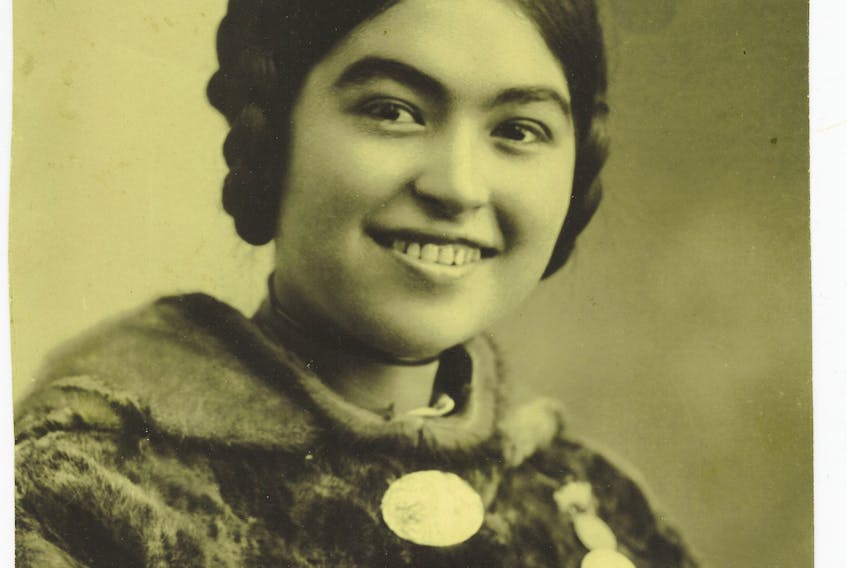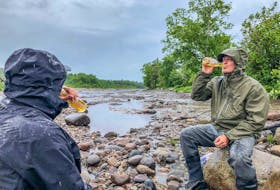She was born at the start of a world fair, spoke four languages, played multiple instruments and was a well-known child performer. She wrote and starred in her own movie at the age of 18. Born in Chicago to a 15-year-old Labrador Inuit mother, her amazing story is worthy of a Hollywood movie.
The name of Nancy Columbia is not well known in Labrador but, in her time, she was the most famous Inuk in the world.

Historian and author Kenn Harper was drawn by her story. He’s spent the past 10 years writing a book about the woman who was the first Inuit movie star and screenwriter.
At a lecture at Memorial University in November Harper said his interest in Nancy Columbia began when a woman brought him a newspaper photo of an Inuit family in what was known as an “ethnographic exhibition.” These travelling exhibitions, in which people from exotic and more remote locales were put on exhibit, were popular in the 1800s.
He began to find old pictures of a beautiful, young Inuit woman whose name was Nancy.
Who was she?
At her birth in Chicago, she was named Nancy Helena Columbia Palmer, a daughter to unmarried Esther from Nain and a Labrador settler named David Edmunds.
Nancy was born at the Chicago’s World Fairground and travelled the world with her family and other Inuit, visiting Africa, Europe and extensively travelling in North America.
When she was a toddler her grandparents moved back to Labrador, taking her with them. Her mother Esther remained in the United States.
Nancy spent three years of her childhood in Labrador. When her mother came with a promoter, Nancy, her grandparents and a group of Inuit hit the road again in1892, touring the world as part of ethnographic shows and demonstrations.

Nancy was different than the others, Harper said. She appeared to enjoy the camera.
“When you look at photographs of people in these displays, often they don’t look very happy,” he said. “Sometimes they look neither happy nor sad but just kind of disinterested. Not Nancy. She generally smiles, she usually looks directly at the camera and she sometimes even shows defiance in her facial expression. She was learning how to turn the ethnographic exhibition to her advantage and to thrive.”
Movies caught her attention and it wasn’t long before she and her family members began to show up in silent films, usually playing indigenous Americans.
Harper said there was a “look” filmmakers wanted at the time and Nancy and her family seemed to fit the bill more than the local indigenous population.
In 1911 Nancy went to Michigan where she made two movies.
“Way of the Eskimo” was a “romance enacted on the snowfields of Labrador,” and was given good reviews the world over. She wrote, directed and acted in the silent film.
“Nancy wrote the script to this movie,” Harper said. “That makes her the first Inuit screenwriter ever.”
The second movie was titled “Lost in the Arctic.”
Both movies were lost. In that era, most silent movies were made on a single reel and archival copies do not exist.
Harper managed to track down promotional material for “Way of the Eskimo” at a film library in Hollywood, and a continuity sequence — similar to a script.
Nancy and her mother Esther were among the first Inuit actors and performed in at least 19 movies.

The last movie Harper could find proof Nancy was in was the 1920s version of “Last of the Mohicans”, which has been remade several times since.
Nancy retired from the movie business and settled down in California, raising a daughter. Harper managed to track down the daughter. She gave Harper a large collection of photos belonging to her mother.
“When I found her, she was 78 years old and had a box of the family’s movie days,” he said.
He also managed to find a great-nephew of Nancy’s, who lives in California.
Between the three of them, Harper has managed to pull together a very comprehensive history of Nancy Columbia.
Nancy passed away in 1959. Her mother Esther outlived her by two years and is buried beside her daughter.
Harper said his book, close to completion, has been a long time coming. It’s taken him from Labrador to Europe to the United States.
“The research has been so interesting,” he said. It’s one of those things where you don’t feel you ever want the research to end."











